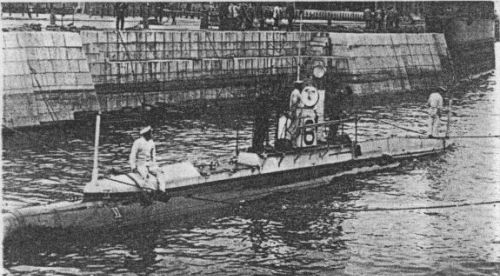

6-go 1907
|
Names |
第6号艦 [6-go] 第7号艦 [7-go] |
|
Builders |
Kawasaki, Kobe: 6-go, 7-go |
|
Commissioned |
3/1906: 6-go, 7-go |
|
Losses |
none |
|
Transfers |
none |
|
Discarding |
1920: 6-go, 7-go |
|
Displacement standard, t |
|
|
Displacement normal, t |
7-go: 78 / 95 8-go: 57 / 63 |
|
Length, m |
7-go: 25.7 oa 24.4 pp 8-go: 22.5 |
|
Breadth, m |
7-go: 2.40 8-go: 2.10 |
|
Draught, m |
7-go: 2.30 8-go: 2.00 |
|
No of shafts |
1 |
|
Machinery |
1 gasoline engine / 1 electric motor |
|
Power, h. p. |
300 / 22 |
|
Max speed, kts |
8.5 / 4 |
|
Fuel, t |
petrol 1.4 |
| Endurance, nm | 184(8) / 12(4) |
| Armament |
1 - 450 TT (bow, 1) |
|
Complement |
14 |
|
Diving depth operational, m |
30 |
Project history: Nos 6 and 7 (Kaigun-Holland type) were built at Kawasaki, Kobe under Holland supervision between November 1904 and March 1906. Compared to the first Holland submarines, they displaced less, but were longer and stronger, with greater engine power, 300hp gasoline v 180hp Otto in the first boats. The Japanese Navy reportedly considered them experimental units for material and tactical trials, hence the single torpedo. Note also the change in emphasis compared to the original Holland concept, surface speed being much greater than submerged. This was typical of other navies at the time, as boats were expected to cruise out to their operating areas on the surface, diving to attack.
Modernizations: None.
Naval service: 6-go sank in about 10 fathoms on 15 April 1910 after the ventilator valve flooded in Hiroshima Bay off Kure, the fortitude of Lt Sakuma's crew (16 dead) becoming famous. She was raised the next day and became a memorial at Kure after being stricken in 1920.

6-go 1916
© Ivan Gogin, 2014